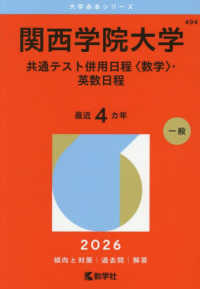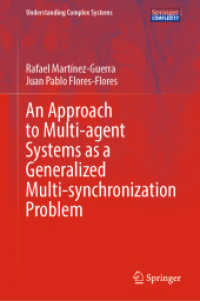- ホーム
- > 洋書
- > 英文書
- > Philosophy
Full Description
The socio-cultural phenomenon of digital enhancement, that is, the attempt to perfect the subject's offline life by means of digital media, seduces people into participating in digitalization. Subjects paradoxically want to participate in digital change even though it is well known that digitalization also impairs their freedom and privacy, and this book investigates both the freedom-impairing and the freedom-enhancing aspects of digital enhancement. Sarah Bianchi provides an empirically informed critical aesthetic diagnosis, a perspective that makes the overlooked affect- and power-sensitive Janus face of subjectivity in digital enhancement perceivable: the subjects' desire to be governed by the logic of perfection—that is, the heart of digital enhancement—and their simultaneous desire for self-government. To this end, An Aesthetic Critique of Digital Enhancement: Government of the Self and Desire makes Foucault's "history of the present" in its Nietzschean genealogy productive for contemporary critical thought on digital enhancement. Through genealogical critique, this approach provides the needed semantics to question the costs of our digital present and to conceptualize how an enlightened agency might be critically constructed.
Contents
Introduction: On Digital "Re-Evaluation" or What is Digital Enlightenment Today?
Part I: Mapping the Field of Digital Enhancement
Chapter 1. The Enlightenment App Does Not Need to be Invented or What is Digital Enhancement?
Chapter 2. On the Enlightened Gaze or What is Aesthetic Critique?
Part II: The Critical-Theoretical Microanalysis of the Present Digital Time or on the Enlightenment Test
Chapter 3. On Today's "Serene Asceticism" After Nietzsche
Chapter 4. Knowledge/Power, Affect/Life Formation: On The Affect- and Power-Sensitive Janus Face of Subjectivity in Digital Enhancement after Foucault
Chapter 5. On the De-Reifying Test: The Janus face of Subjectivity in Digital Enhancement in Terms of Affective Imaginary Reification
Part III: When Scenes of Affect-Centered Power Relations can be the Beginning of the Subject's "Flight"
Chapter 6. Updating the Resources
Chapter 7. The Basic Method: How Enlightened Stumbling Blocks Can Activate An Intrasubjective Communication
Chapter 8. Activating in General: A Procedure of Translation
Chapter 9. Activating Specifically: Realizing that "Flight Is an Option"
Conclusion: Aesthetic Critique of Ourselves: Relationality, Structural Epistemic Discrimination, and Structural Epistemic Anti-Discrimination







